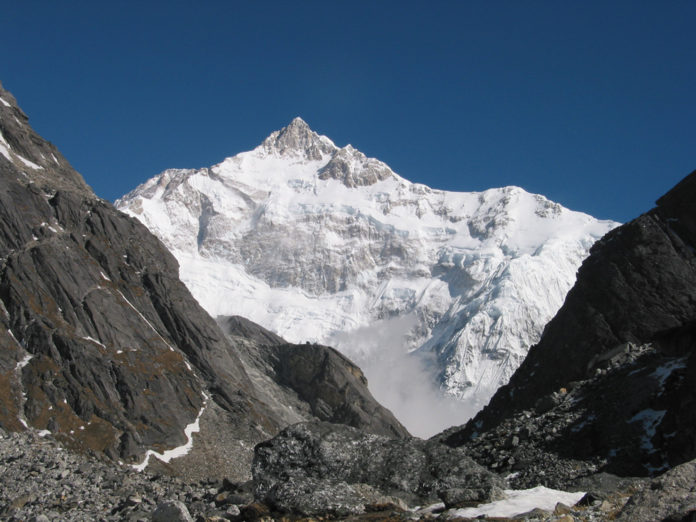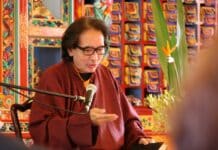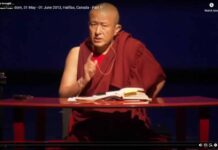
Dear fellow sangha of the incomparable Vidyadhara, Chogyam Trungpa Rinpoche,
Ki! Greetings from the Shambhala Belt, as the Vidyadhara called the area I have been living in for 12 years and am writing from.
It is already the 4th of April here in Sikkim, originally named Demajong by Guru Rinpoche, “the Valley of Fruit, Rice, and Treasure.” It is dawn, and Mt. Kangchendzonga is wrapped in the imperial robes of Himalayan mists, the ones the Vidyadhara once said were the abode of actual dragons. Mt. Kangchendzonga is the King of all the deities of Sikkim, the supreme drala of this sacred land, hidden and predicted as the site for an enlightened society by Guru Rinpoche. It feels particularly fitting to perform a lhasang here under his towering throne as a beginning to the 20th anniversary of the Vidyadhara, the Dorje Dradul, the Sakyong King. I just returned to my desk from that lhasang on my roof.
In Sikkim, the Vidyadhara’s presence echoes in every corner, from the caves of Guru Rinpoche where he subdued the demons who would obstruct dharma and where he established enduring spiritual practice and power, to the grand throne of the King of Dralas, Kangchendzonga, to the stories and remembrances of local lamas and lay people, and perhaps most poignantly, in the history and enduring presence of Sikkim itself. During the reign of the Namgyal Dynasty, as prophesized by Guru Rinpoche, this hidden land of Demajong became a grand adventure in creating an enlightened society.
There are a number of people here who knew the Vidyadhara. Perhaps starting with Dodrupchen Rinpoche, who the Vidyadhara remarked to a few of us, after meeting with him in Berkeley in 1972, was one of three living crazy wisdom people in the world then, including also Dilgo Khyentse Rinpoche and himself. There is Barmiok Rinpoche, the Honorable Tashi Densapa, whose father was the Personal Secretary to the last Chogyal (Dharma King) and is himself a consummate Shambhalian gentleman and diplomat. He sponsored Naropa University establishing a program here five years ago, remarking to me then that he had known and had the highest regard for Trungpa Rinpoche. He said he would do anything in his power to help bring a Naropa University program to Sikkim as the first-ever western educational institution to be granted the privilege of taking up residence here in this restricted corner of the world. There is my friend Abey, now married, who grew up as a monk at Rumtek and heard the Karmapa extol Trungpa Rinpoche, saying Trungpa Rinpoche could do anything he wanted and it was utterly appropriate, as he was a supreme lama and siddha. The monks grew up regarding Trungpa Rinpoche as a living legend, he says. There is the Indian owner of the Hotel Tashi Delek, who remembers well the Vidyadhara and entourage of students, guards and attendants who attended Karmapa Rigpe Dorje’s cremation, and the constant stream of people at the hotel queuing up for the Vidydhara’s blessing. There is Ringu Tulku Rinpoche, who, when the Vidyadhara first returned to Delhi after his monumental retreat at Taktsang in Bhutan, was one of three or four people to whom the Vidyadhara spontaneously bestowed the first Abhisheka for the Sadhana of Mahamudra, using soft drink bottles as the Abhisheka vases and composing the abhisheka liturgy as he gave it.
It is said that when he first landed in Sikkim, Guru Rinpoche came down from the sky onto the peak of Tashi Ding, now the center and most sacred spot of the Sikkim mandala. He descended disguised as a vulture, to fool the local deities, then immediately began subduing obstructing spirits, meditating in and blessing four directional caves which became the gates of the mandala. (He met Vajrayogini face-to-face in one). He hid terma which when later uncovered, would become the principle and sustaining practices of Sikkim, defining the place as a geographical mandala of his own Copper Colored Mountain pure land. He set into motion the causes and conditions for a future dharma kingdom.
I cannot but see a parallel in the Vidyadhara’s landing for the first time in North America, and how everything that followed was so parallel to the Buddha Activity of Guru Rinpoche in Sikkim. And like Guru Rinpoche in Sikkim, the Vidyadhara swooped down onto the American continent like a grand bird! Perhaps a Garuda in the Vidyadhara’s case!
I can still remember the shivers going up my spine when, at the Crazy Wisdom Seminar in Jackson Hole, Wyoming, in 1972, the Vidyadhara, while presenting the pith of the outer, inner, and secret meaning of Guru Rinpoche, at one point paused and remarked (paraphrasing), “I am sure that if Guru Rinpoche were here…and he is!…that he would express his approval at what you are doing.” It was at that moment, and thereafter, that I knew the Vidyadhara was Guru Rinpoche himself.
So! From here in the sacred, enlightened Kingdom of Demajong, to you in the sacred, enlightened Kingdom of Shambhala, a sad and tender, heartfelt greeting on the day commemorating the inseparability of Guru Rinpoche and the Dorje Dradul, the Sakyong King of Shambhala. May all enlightened kingdoms coincide in the glory of the Great Eastern Sun, and may we all auspiciously connect and work together for the benefit of all beings, like the rays of the Great Eastern Sun!
Ki Ki So So! And Tashi Delek,










